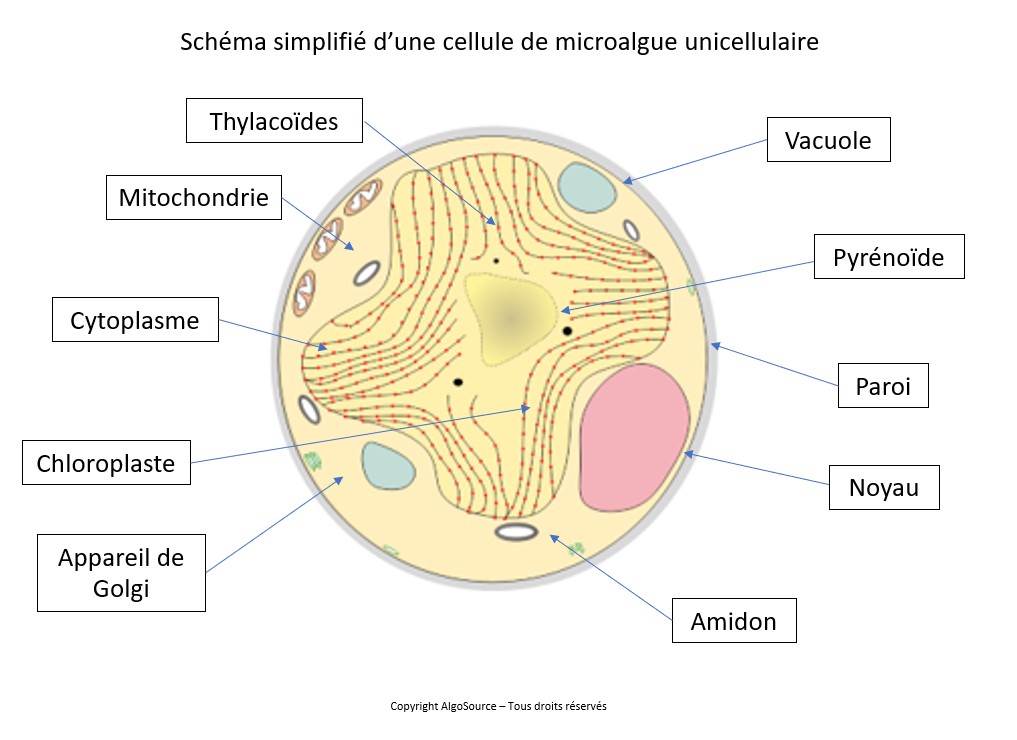Les microalgues en questions
Les microalgues, qu’est-ce que c’est ?
Nous connaissons tous les algues que l’on trouve l’été sur les plages, comme le goémon ou le varech, ramassées par les paysans qui s’en servent comme engrais naturel dans les champs bretons et normands, ou bien celles que l’on mange comme les feuilles de nori qui enrobent de leur belle couleur noir brillant les fameux makis japonais.
Mais connaissez-vous les microalgues, ces minuscules petits organismes qui sont pourtant parmi les premiers êtres vivants apparus sur la Terre ? Font-elles partie de la même famille que les algues ou macroalgues que l’on voit sur les plages ? Quel est leur rôle et surtout, à quoi peuvent-elles servir ?
Voici quelques éléments de réponses à ces questions ; vous découvrirez alors que petite taille peut être synonyme de grands pouvoirs !
Mais connaissez-vous les microalgues, ces minuscules petits organismes qui sont pourtant parmi les premiers êtres vivants apparus sur la Terre ? Font-elles partie de la même famille que les algues ou macroalgues que l’on voit sur les plages ? Quel est leur rôle et surtout, à quoi peuvent-elles servir ?
Voici quelques éléments de réponses à ces questions ; vous découvrirez alors que petite taille peut être synonyme de grands pouvoirs !
Comment différencier macro et microalgues ?
Algues est le nom de famille commun aux très grandes comme aux toutes petites algues qui existent sur Terre. Elles ont comme point commun d’être capables de se développer et de se multiplier par photosynthèse. La photosynthèse, c’est cette merveilleuse capacité qu’on les végétaux à absorber le gaz carbonique (ou C02) et avec l’aide de la lumière du soleil, de l’eau et de quelques sels minéraux pour les algues, de rejeter de l’oxygène dans notre atmosphère. C’est ainsi qu’elles se développent et grandissent.
Pour différencier macro et microalgues, il faut regarder leur taille et leur structure moléculaire, c’est-à-dire la manière dont est construit leur « corps ». Mais avant de les disséquer, quelques éléments visuels permettent de les reconnaitre.
D’abord, la taille. La taille d’une algue peut varier de quelques micromètres à plusieurs mètres et permet de les classer en deux groupes :
– Les macroalgues ou phytobenthos sont les espèces qui se fixent au fond de l’eau par un thalle, sorte de pied sans racines qui leurs permettent néanmoins de s’accrocher sur un support.
– Les microalgues ou phytoplancton qui, elles, ne peuvent se fixer et se retrouvent en suspension dans les milieux aquatiques.
Puis, la couleur. Les algues n’assimilent pas la chlorophylle, couleur verte naturelle issue de la photosynthèse, de la même manière ; elles ont donc des couleurs variées. Ainsi les macroalgues se définissent en trois groupes de couleurs différentes :
– Les algues vertes ou chlorophytes
– Les algues brunes ou chromophytes
– Les algues rouges ou rhodophytes.
Les microalgues, sont extrêmement nombreuses : environ 30 000 espèces ont été recensées (sur un nombre total estimé de plus d’un million) dont 14 000 vivant en eaux douces. Une cinquantaine de spécimens est actuellement étudiée par les scientifiques dont :
– Les Diatomées
– Les Flagellées
– Les Chlorophycées
– Les Chrysophycées
– Les Cyanophycées qui sont celles sur lesquelles nous allons nous attarder.
Pour différencier macro et microalgues, il faut regarder leur taille et leur structure moléculaire, c’est-à-dire la manière dont est construit leur « corps ». Mais avant de les disséquer, quelques éléments visuels permettent de les reconnaitre.
D’abord, la taille. La taille d’une algue peut varier de quelques micromètres à plusieurs mètres et permet de les classer en deux groupes :
– Les macroalgues ou phytobenthos sont les espèces qui se fixent au fond de l’eau par un thalle, sorte de pied sans racines qui leurs permettent néanmoins de s’accrocher sur un support.
– Les microalgues ou phytoplancton qui, elles, ne peuvent se fixer et se retrouvent en suspension dans les milieux aquatiques.
Puis, la couleur. Les algues n’assimilent pas la chlorophylle, couleur verte naturelle issue de la photosynthèse, de la même manière ; elles ont donc des couleurs variées. Ainsi les macroalgues se définissent en trois groupes de couleurs différentes :
– Les algues vertes ou chlorophytes
– Les algues brunes ou chromophytes
– Les algues rouges ou rhodophytes.
Les microalgues, sont extrêmement nombreuses : environ 30 000 espèces ont été recensées (sur un nombre total estimé de plus d’un million) dont 14 000 vivant en eaux douces. Une cinquantaine de spécimens est actuellement étudiée par les scientifiques dont :
– Les Diatomées
– Les Flagellées
– Les Chlorophycées
– Les Chrysophycées
– Les Cyanophycées qui sont celles sur lesquelles nous allons nous attarder.
Comment sont-elles faites ?
Nous allons disséquer une microalgue pour regarder sa structure moléculaire, en quelque sorte son intérieur.

La plupart des macro et microalgues sont eucaryotes, c’est-à-dire qu’elles contiennent un noyau qui protège le matériel génétique de l’organisme.
Les Cyanophycées, quant à elles, sont des organismes procaryotes, c’est-à-dire qu’elles ne possèdent pas de noyau, se rangeant donc dans la catégorie des bactéries.
Appelées également microalgues bleues, ces cyanobactéries sont les êtres vivants primitifs de la Terre, apparues il y a environ 3,5 milliards d’années ; elles sont aux origines de la vie sur notre planète. Elles sont les premières à avoir utilisé l’énergie solaire pour transformer le gaz carbonique et l’eau afin de libérer de l’oxygène. C’est donc en partie grâce à elles que l’être humain respire !
Quel est leur rôle sur la Terre ? Où les trouve-t-on ?
Les microalgues sont présentes partout sur notre planète, elles ont la capacité de s’adapter à toutes sortes de milieux, même hostiles, car on les retrouve de l’Antarctique au Sahara, au fond des océans ou dans les sources d’eau douce.
Elles représentent à elles seules les deux tiers de la biomasse terrestre.
Elles représentent à elles seules les deux tiers de la biomasse terrestre.
A quoi servent-elles ?
Elles sont aujourd’hui encore la source principale de production d’oxygène de la Terre. Elles sont une véritable chance pour l’être humain. Cela nous donne une responsabilité quant à leur protection et leur préservation. On estime qu’elles produisent 70% de la totalité d’oxygène libre de notre planète tout en consommant une quantité infime de ressources naturelles.
Les microalgues font l’objet de nombreuses recherches scientifiques car leurs applications dans nos vies quotidiennes sont un véritable enjeu d’avenir.
On les retrouve déjà dans nos assiettes, dont les plus consommées sont sans nul doute :
– La Chlorelle, de la famille des Chlorophycées que l’on retrouve sous forme de gélules ou de poudre
– La Spiruline, de la famille des Cyanophycées que l’on retrouve sous forme de paillettes, de gélules ou de poudre sous sa forme sèche et de Spirulysat® sous sa forme liquide.
Ces deux microalgues sont actuellement les plus cultivées sous forme artisanales ou industrielles.
De plus en plus de microalgues font également l’objet d’études poussées pour exploiter le potentiel fonctionnel exceptionnel qu’elles renferment. Dans ce cadre, AlgoSource est, depuis près de trente ans, l’un des principaux acteurs européens visant, par exemple, à proposer au secteur cosmétique des ingrédients bioactifs naturels pour leurs formulations ou au secteur de la santé des soins de support ou de prévention parfaitement complémentaire des protocoles médicamenteux.
Les microalgues font l’objet de nombreuses recherches scientifiques car leurs applications dans nos vies quotidiennes sont un véritable enjeu d’avenir.
On les retrouve déjà dans nos assiettes, dont les plus consommées sont sans nul doute :
– La Chlorelle, de la famille des Chlorophycées que l’on retrouve sous forme de gélules ou de poudre
– La Spiruline, de la famille des Cyanophycées que l’on retrouve sous forme de paillettes, de gélules ou de poudre sous sa forme sèche et de Spirulysat® sous sa forme liquide.
Ces deux microalgues sont actuellement les plus cultivées sous forme artisanales ou industrielles.
De plus en plus de microalgues font également l’objet d’études poussées pour exploiter le potentiel fonctionnel exceptionnel qu’elles renferment. Dans ce cadre, AlgoSource est, depuis près de trente ans, l’un des principaux acteurs européens visant, par exemple, à proposer au secteur cosmétique des ingrédients bioactifs naturels pour leurs formulations ou au secteur de la santé des soins de support ou de prévention parfaitement complémentaire des protocoles médicamenteux.
Vous souhaitez en savoir davantage sur nos produits, nos ingrédients issus des microalgues et nos savoir-faire ?
